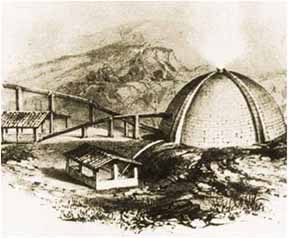
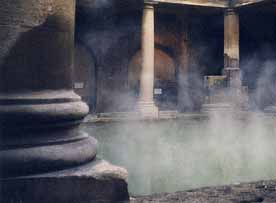
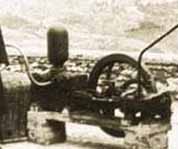
A Brief History of Geothermal Energy Use
The use of geothermal energy by humans dates back over 10,000 years to the time when humans first lived in caves. Indigenous peoples throughout the world have used the Earth’s heat to prevent vegetables from spoiling or freezing by storing them in root cellars. Early Native Americans used hot springs for warmth, bathing, cooking, medicinal purposes and as locations for social gatherings. According to the United States Department of Energy (DOE), “Hot springs were neutral zones where members of warring nations would bathe together in peace”(http://www1.eere.energy.gov/geothermal/history.html). Hot Lake in Oregon is one such place. Roman baths are another example of an ancient geothermal application. The first documented geothermal district heating system was developed at Chaudes-Aigues in France in the 14th Century and is still in operation today (Lund 2006, 48).
 |
 |
 |
| "Covered Lagoon," built in Larderello, Italy in 1827 to collect boric acid from geothermal waters through evaporation Source: Dickson and Fanelli 2004, 4 | Roman Bathes, Bath UK, Photo by Isabella Perry, Flikr.com | The first geothermal electric engine. Source: Dickson and Fanelli 2004, 5 |
As European settlers moved west across North America in the 1800s they also began settling near hot springs in such places as Hot Springs, Arkansas, founded in 1807. The first known commercial use of geothermal energy occurred there in 1830 when Asa Thompson began charging for the use of spring-fed baths (http://www1.eere.energy.gov/geothermal/history.html). In the latter half of the Nineteenth Century spas developed around geothermal vents such as hot springs and geysers. The Geysers Resort Hotel opened in 1852; four years after William Bell Elliot and the John C. Fremont survey party “discovered” The Geysers 70 miles north of San Francisco. In 1864 the establishment of the Hot Lake Hotel near La Grande Oregon incorporated the first large-scale use of energy from hot springs.
The first geothermal district heating system in the United States was created in Boise, Idaho, in 1892. While many individual buildings used geothermal heating, another district heating system was not constructed in the United States until the Oregon Institute of Technology constructed one in 1964. The oil crisis of the 1970s and high fuel costs in this period rejuvenated interest in geothermal district heating in the U.S. Nineteen systems went into operation after 1979, most during the 1980s. The most recently created system in the U.S. went into operation in 2005 in Lakeview, Oregon (Thorsteinsson 2008, 52). In 1930, Reykjavik, Iceland, began using geothermal district heating and Reykjavik District Heating (now called Reykjavik Energy) was established in 1943 (Lund 2005, 19). Today, there are 21 district heating systems in the United States and 22 in Iceland where 89% of the nation’s space heating needs are met by geothermal district heating (Thorsteinsson 2008, 26).
In 1904, Prince Piero Ginori Conti invented the first geothermal power plant at the Larderello dry steam field in Italy. This plant is still operating. In 1922 John D. Grant helped to establish the U.S.’ first geothermal power plant at The Geysers, but the 250 kilowatt (kW) plant could not compete with cheap fossil fuels and was short lived. However, in 1960 Pacific Gas and Electric began operating the United States’ first large scale geothermal power plant at The Geysers with capacity of 11 megawatts (MW). Today there are 23 power plants at The Geysers with a combined capacity of 2043 MW. Calpine owns 15 plants with a combined capacity of 725 MW - enough energy to meet the needs of 725,000 homes. The Geysers plants meet roughly 60% of the energy needs of the North Coast region which runs from the Golden Gate Bridge to the Oregon border (http://www.geysers.com/default.htm).
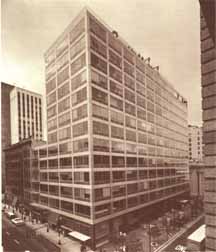 |
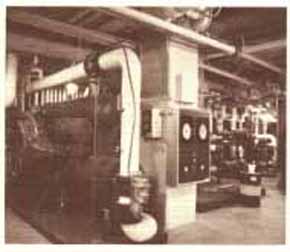 |
The Commonwealth Building, formerly
the Equitable Building |
Heat Pump in the Commonwealth Building Source: ASME |
The first commercial ground-source geothermal heat pump went into operation in 1948 at the Equitable Building, now called the Commonwealth Building in Portland, Oregon. Because it pioneered the large scale commercial application of heat pumps the building was named a National Historic Mechanical Engineering Landmark by the American Society of Mechanical Engineers (ASME) in 1980.
During the 1970s the U.S. government established a number of programs and enacted legislation to encourage the exploitation of geothermal energy. The use of groundwater heat pumps rose in popularity during this decade (Rafferty 1997, 1). The decade also saw an expansion of industrial applications of geothermal energy including its use for food processing and crop drying. The first Hot Dry Rock facility, a type of Enhanced Geothermal System (EGS) for producing electricity, was created at Fenton Hill, New Mexico in 1978 (http://www.repp.org/geothermal/geothermal_brief_history.html).The 1980s saw a rapid increase in the number of district heating systems in the United States. It also saw advances in technology for geothermal power plants with successful demonstrations of flash steam systems and binary cycle systems. Ground source heat pumps gained wide use beginning in the mid 1980s as well (Rafferty 1997, 1). During the 1990s the global geothermal heat pump market grew rapidly in the United States and Europe. The market also grew, though to a lesser extent, in other countries around the world. This rapid growth has continued during the first decade of the century.
In 2005, 77 countries combined for 28,268 MW of installed thermal capacity resulting in an estimated 75,943 GW of annual energy use (Lund 2006, 48). This was an increase from the 55 countries reporting direct use (not electricity generation) in 2000 and 24 countries in 1997 (Lund and Freeston 2000, 1). (A significant portion of this reported increase may, however, simply be due to better reporting.) In 2005 the direct use installed capacity and annual energy use by application was as follows: geothermal heat pumps 56.5% and 33.2%; bathing/swimming/spas 17.7% and 28.8%, space heating (80% of which was supplied by district heating) 14.9% and 20.2%; greenhouse heating 4.8% and 7.5%; aquaculture 2.2% and 4.2%; industrial 1.8% and 4.2%; agricultural drying 0.6% and 0.8%, cooling and snow melting 1.2% and 0.7%; and others 0.3% and 0.4% (Lund 2006, 49). In terms of total direct use in 2000, the top four countries – China, Iceland, the United States and Turkey – together employed over 50 percent of the world wide total. The countries most rapidly increasing their use of geothermal from 1995 to 2000 were Austria, Canada, Sweden, Switzerland (mostly through heat pumps), and Turkey (through numerous new district heating systems). The world leaders in geothermal district heating remain France, Iceland, Turkey, China, and Japan (Lund and Freeston 2000, 2). From 2000 to 2005 the heat pump market boomed with installed capacity increasing at 24% annually and energy production from geothermal heat pumps increasing by 30% annually. In 2005 heat pumps accounted for 56% of total installed capacity and 33% of geothermal energy use (Lund 2006, 50). In the U.S., direct use for space heating is dominated by individual home systems. One of the fastest growing applications is fish farming, i.e. aquiculture pond and raceway heating. The use of heat pumps has continued to grow at approximately 10% per year during this decade (Goetzler et al 2009, 14). Heat pump installation is concentrated in the Midwestern and Southern states.